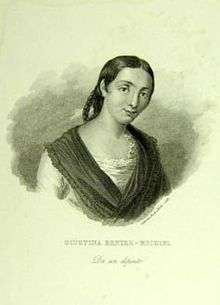Giustina Renier Michiel
Giustina Renier Michiel (1755–1832) was an aristocratic woman who helped intellectual and social Venetian life flourish.[1]

Early life
She was born on 14 October 1755 to Andrea Renier, later Doge and son of Paolo Renier (penultimate doge), and Cecilia Manin, sister of Ludovico, the last doge, in Venice.[1] She learned English, French, Music, Art, Math and Natural History when she was sent to a convent of Capuchin nuns at Treviso at the age of three.[2] She was brought back to Venice at the age of nine and placed in a fashionable boarding school kept by a Frenchwoman.[2] She was considered a bookworm and a woman with an independent mind.[2]
Marriage
At the age of 20 she married Marc Antonio Michiel on 25 October 1775.[3] They followed her father to Rome, not long after, where he had been named the Venetian ambassador to Pope Pius VI.[3] Though she only stayed one year she made a profound impression on the Roman society and was given the nickname Venerina Veneziana, Venetian Venus.[2] It was during this trip that Giustina gave birth to a daughter in 1776, Elena.[3] They had two other daughters who were born over the course of the next two years, Cecilia and Chiara (died at age ten).[3] She was often left alone with her children while her husband traveled and so she was unhappy and ended up getting a divorce from her husband on 4 August 1784[3] Their divorce left her free to enjoy an active social life, which had been something her husband did not approve of.[3]
When she came back from her yearlong stay in Rome, her father’s brother was elected doge. Because the people refused to accept his wife Margherita Delmaz, a dancer, as a dogaressa, Giustina Renier Michiel had to step in.[2] She served as first lady in all official ceremonies when necessary between the years of 1779 and 1789 while also pursuing her intellectual passions and hosting a literary salon.[3]
Salon
Giustina Renier Michiel’s salon was considered one of the two most in vogue salons of Venice, the other being that of her friend Isabella Teotochi.[4] There was a particularly Venetian character to her salon and it was frequented by well-known literary figures such as Ippolito Pindemonte, Marina Querini Benzon, Ugo Foscolo, Giustiniana Wynne (Countess Rosenberg), the French Madame de Staël and the English Lord Byron.[3] She built connections between people, introducing scholars to one another, and promoted socializing and intellectual conversation.[3] Her salon was not all about intense intellect; it had a good stream of recreational pleasure. Vittorio Malamani had said that her guests often arrived after midnight once the theater finished in order to discuss the works that they had just seen and to play "society games."[3]
When Napoleon invaded Venice, she closed her salon and pursued the study of botany and the publishing of her Shakespeare translations for the next ten years.[3] She translated Othello and Macbeth in 1798 and Coriolanus in 1800 from English to Italian.[5]
Publication
During this time she also started her monumental work published in six volumes, Le origine delle feste veneziane.[6] The book was heavily researched and was an extensive look into Venice’s festivals, myths and public rituals.[6] This collection of Venetian traditions was one way in which she tried defending Venice and its history.[2] "She seemed to make it her duty to prevent anything from disturbing the ghost of the defunct republic."[2]
Later life
She eventually reopened her salon and held it thus till her death. She was a patroness of Canova and a correspondent with Chateaubriand.[7] She wrote many letters, many of which went to her niece Adriana Zannini, Marc Antonio Michiel, Contessa Marina Beneti Cicciaponi and many others.[3] In her later years she had to wear an ear trumpet for she became deaf.[8] On April 6, 1832 she died surrounded by her friends and grandchildren at the age of 77.[2]
References
- Panizza, Letizia (2000). A History of Women's Writing in Italy. Cambridge University Press. p. 325. ISBN 0521578132.
- Crawford, F. Marion (1909). Venice, the Place And the People: Salve Venetia; Gleanings From Venetian History. New York: Macmillan. p. 254. hdl:2027/uc2.ark:/13960/t0bv7m539.
- Dalton, Susan (2004). Engendering the Republic of Letters: Reconnecting Public and Private Spheres in Eighteenth-Century Europe. McGill-Queen's Press - MQUP. ISBN 0773571523.
- Molmenti, Pompeo (August 1906). Venice, Its Individual Growth From the Earliest Beginnings to the Fall of the Republic: by Pompeo Molmenti; Tr. by Horatio F. Brown. London: J. Murray. p. 147. hdl:2027/mdp.39015008805502.
- Pellegrini, Giuliano (December 1957). "The Roman Plays of Shakespeare in Italy". Italica. 34 (4): 230. doi:10.2307/477668. JSTOR 477668.
- Muir, Edward (1986). Civic Ritual in Renaissance Venice. Princeton University Press. p. 61. ISBN 0691102007.
- Fletcher, Jennifer (October 1981). "Marcantonio Michiel, 'che ha veduto assai'". The Burlington Magazine. 123 (943): 602–609. JSTOR 880372.
- Hale, S. Josepha Buell (1855). Woman's record, or, Sketches of all distinguished women: from the creation to A.D. 1854 : arranged in four eras : with selections from female writers of every age. New York: Harper & Bros. p. 428. hdl:2027/nyp.33433067276471.